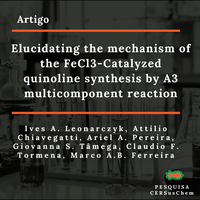Artigo ‘Elucidating the mechanism of the FeCl3-Catalyzed quinoline synthesis by A3 multicomponent reaction’ recém publicado na edicação especial da revista Tetrahedron - 'Iron Catalyzed Organic Reaction’., tem co-autoria do Prof. Dr. Marco Ferreira, do CERSusChem
BR
Química Verde
Você sabia que cientistas estão descobrindo formas mais sustentáveis de fazer compostos químicos importantes? É o que mostra o novo estudo com coautoria do Prof. Dr. Marco Ferreira, do CERSusChem, publicado na edição especial da revista Tetrahedron - ‘Iron Catalyzed Organic Reaction’. O trabalho ‘Elucidating the mechanism of the FeCl3-Catalyzed quinoline synthesis by A3 multicomponent reaction’ revela que é possível criar quinolinas, que são componentes fundamentais em muitos produtos farmacêuticos e agroquímicos, de uma maneira mais amigável ao meio ambiente. Ao invés de usar metais raros, os pesquisadores estão explorando o uso de ferro, um metal mais comum e mais acessível. Isso não só torna o processo mais barato, mas também ajuda a reduzir o impacto negativo no meio ambiente!
US
Green Chemistry
Did you know that scientists are discovering more sustainable ways to make important chemical compounds? That's what the new study co-authored by Prof. Dr. Marco Ferreira, from CERSusChem, published a special edition of Tetrahedron - ‘Iron Catalyzed Organic Reaction’.
The article ‘Elucidating the mechanism of the FeCl3-Catalyzed quinoline synthesis by A3 multicomponent reaction’ reveals that it's possible to create quinolines, which are fundamental components in many pharmaceutical and agrochemical products, in a more environmentally friendly way. Instead of using rare metals, researchers are exploring the use of iron, a more common and accessible metal. This not only makes the process cheaper but also helps reduce the negative impact on the environment!
Link: https://www.sciencedirect.com/science/article/pii/S0040402023005501

